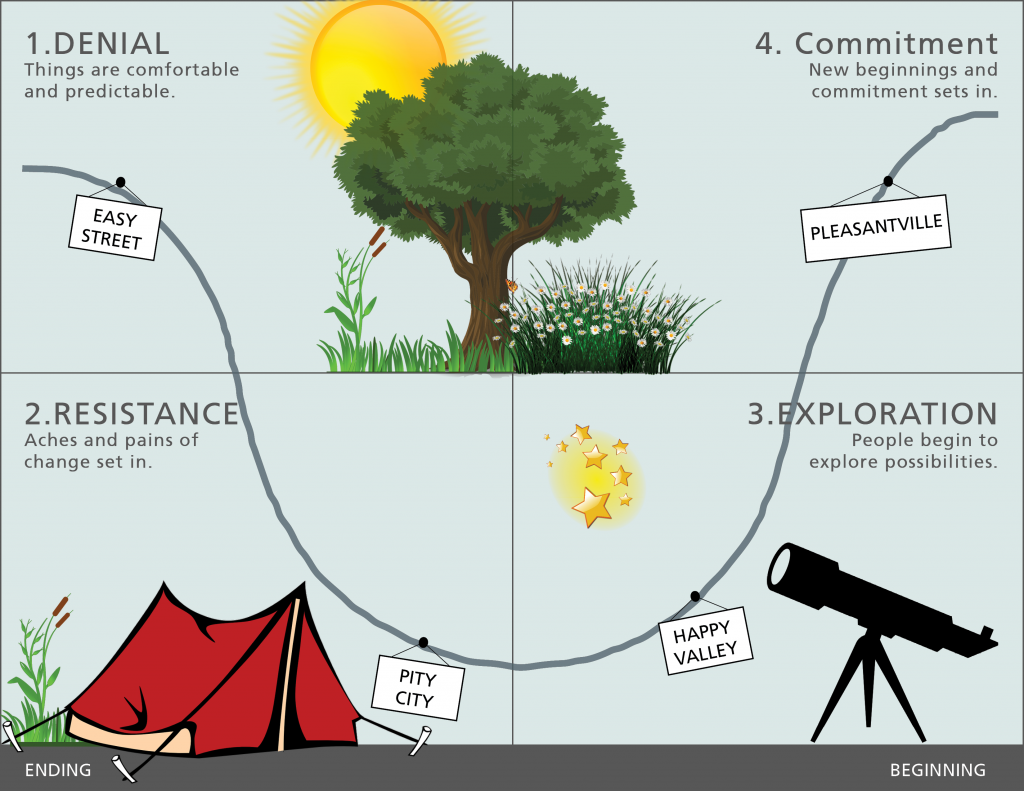Disruption is anything that interrupts our everyday normal. And while sometimes disruption can be welcomed, it can also create frustration, fear, and judgment. Almost always, disruption creates the need for change.
So let’s start there. We all have perceptions of change. Take a moment to consider this question.
Your Perceptions

If change were a motorcycle, would riding it feel:
- Terrifiying
- Exhilarating
- Necessary
- Confusing
- Something to avoid
- Other
While your answer to this question potentially reveals something about your perception of change, it’s important to recognize that there is no wrong answer!
We all have perceptions about change that are based on our past experiences-which can make any kind of change a bit challenging.
The Change Curve
A lot has been done to study the stages of change. The most common model includes four stages of change: Denial, Resistance, Exploration, and Commitment. Change starts with an ending and moves towards a new beginning.


Let’s take a closer look at this curve to see how most people journey through change. Select each of the TABS to discover more.
We will call our starting point Easy Street. This is the point in time where things are comfortable. Individuals understand their role and expected performance. There is certainty and predictability in the air.
However, our customers’ needs change, technology changes, products change, our environment changes, and we change. Because change is all around us, no one can stay on Easy Street for very long and experience the same results.
THOUGHTS AND FEELINGS
The first stage of change begins with denial and is often accompanied with these thoughts and feelings.
Thoughts: Things are fine as they are. Let’s keep it the same. If it’s not broken why are we fixing it.
Feelings: Content, Safe, Comfortable, Confident, and/or Productive.
Soon, things take a sharp turn and head towards Pity City. The aches and pains of change begin to set in. Job responsibilities and normal business operations can be in a state of flux, and your team members may feel anxious, frustrated, and experience a low tolerance for ambiguity. During this phase, individuals can choose to either build momentum to move out of Pity City, or they can choose to take a slower approach and set up camp for a longer or sometimes permanent stay in Pity City. Pity City campers can create a lot of havoc in the clinic.
THOUGHTS AND FEELINGS
The second stage of change heads into resistance and is often accompanied with these thoughts and feelings.
Thoughts: We are doomed. This will never work. I don’t have options.
Feelings: Resistant, Helpless, Doubt, Dismayed, Invisible, Anxious, Defeated and/or Frustrated.
As individuals move out of Pity City they enter Happy Valley, a place of Exploration. This is when individuals start to explore how to respond to the change. They begin to understand the need for change, embrace the new practices, and start to see the value in the change. They may even begin to recommend their own ideas to support the change.
THOUGHTS AND FEELINGS
The third stage of change moves over to exploration and is often accompanied with these thoughts and feelings.
Thoughts: This is our new normal now. What are my options? Where might there be opportunity in the midst of this change?
Feelings: Curious, Expectant, Hopeful, Interested, and/or Intrigued.
The next stop after Happy Valley is Pleasantville, where new beginnings and commitment sets in. Things are once again comfortable and productive, and they eventually lead back to Easy Street, where the change process may begin all over again.
THOUGHTS AND FEELINGS
The fourth stage of change moves to acceptance and is often accompanied with these thoughts and feelings.
Thoughts: Wow these new changes are really making a difference. It seemed impossible first, but now it makes sense. We really made some good enhancements.
Feelings: Accomplished, Pride, Resourceful, Excited, and/or Delight.
There are a couple of key things to note about the Change Curve.
- We all move through the four stages, even when we initiate change, but we may move through each stage at a different rate of speed.
- The road is not a one-way street. It’s possible for individuals to move from Pity City to Happy Valley and back to Pity City again.
Leading Others Through Change
If you lead others, you’ll want to pay attention to where your employees are on the change curve. You’ll most likely be a step or two ahead of your team, but recognize that individuals will go through each stage. Your job is to inspire them move to forward and gain momentum on their way to Phase 4: Commitment.
Remember, your employees look to you for #leadership. Your own emotions are contagious. How can you spark #curiosity and #inspiration for greatness? #emotional intelligence

Take some time to reflect on the disruption you are experiencing. Where are you on this change curve?
Jot down the specific thoughts and feelings you are experiencing. Recognize your feelings as real and allow yourself to experience them.
As you consider each of your feelings, what message are they conveying to you? Perhaps you are feeling helpless. That message might be informing you to talk with someone about what you are experiencing. Or maybe it’s a message to focus on what you can control.
In order for you to continue to move forward through each stage, what new thoughts might impact how you feel about this situation? How can you use some optimistic thinking to see the possibilty?
Share this map with someone else that is experiencing the same change. Where is he/she on the change curve map? What thoughts and feelings is he/she experiencing? How can you support each other?
Copyright ©2020, EQuip Studios www.EQuipStudios.net20
